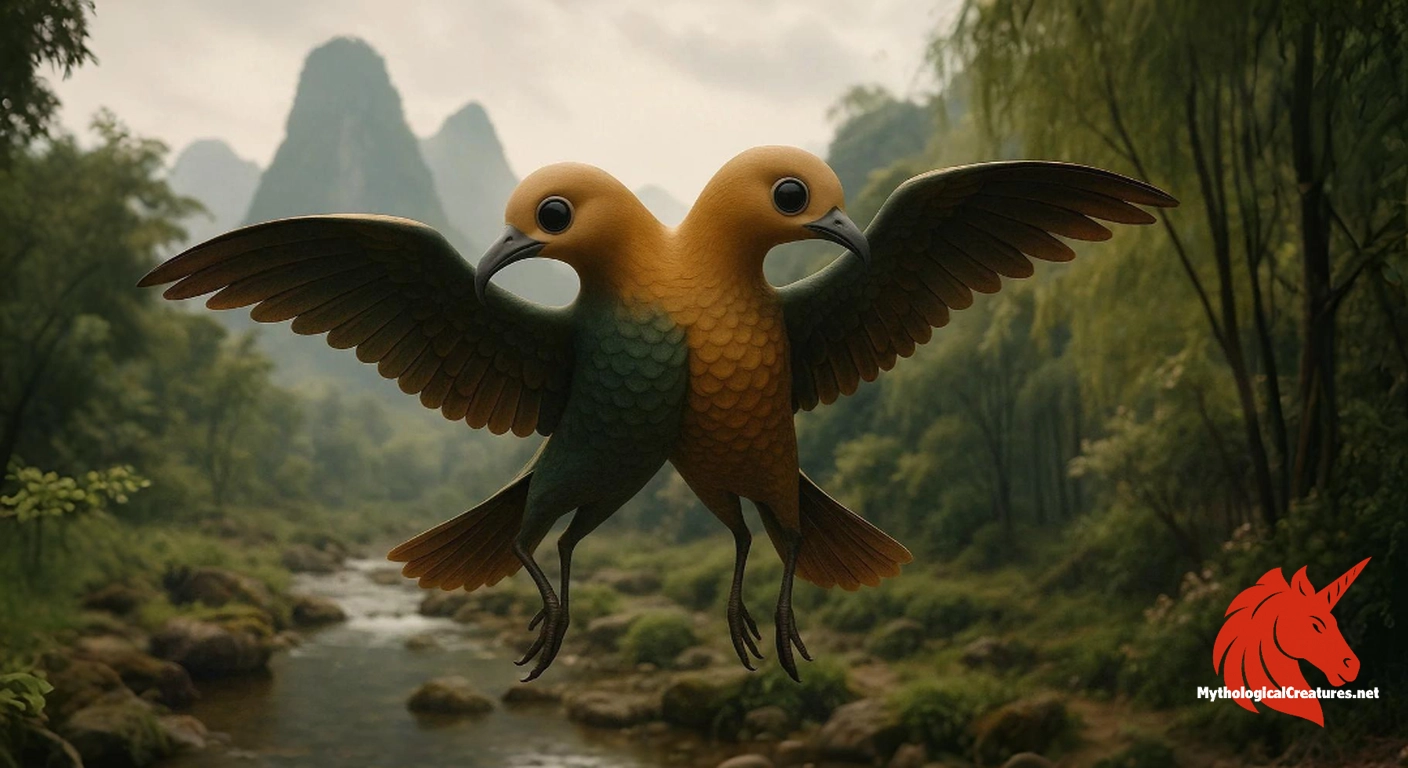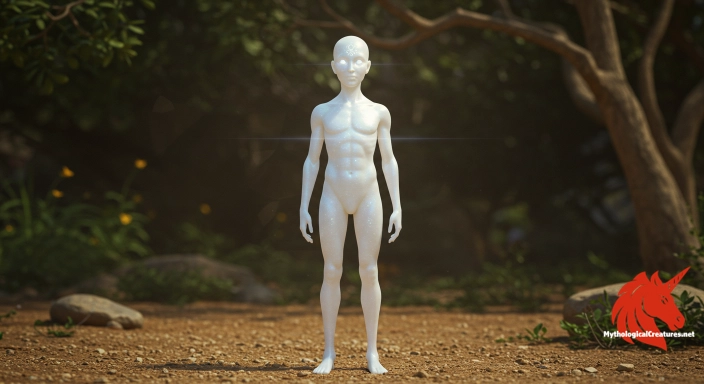Biyiniao: Biyiniao are unique mythological birds from Chinese folklore.

Biyiniao
Biyiniao - Biyiniao are emblematic of partnership and completeness; their unique trait of having only one eye and wing each underscores the idea of interdependence.
Origins & First Encounters
In the tapestry of Chinese mythology, the biyiniao emerges as a distinctive and enigmatic creature that symbolises the vital importance of unity and mutual support. Originating from ancient mythological narratives, these birds are known for their singularly unique anatomy, with each individual possessing only one wing and one eye. They are traditionally depicted as incomplete beings who require a complementary counterpart in order to soar. The earliest records of this fascinating creature appear in the ancient dictionary Erya, where it is identified by the name jianjian. Rooted in deep cultural traditions, the linked-wing birds have come to represent the perfection of partnership and the delicate balance of interdependence. Their portrayal resonates with the philosophical spirit seen in early Chinese thought, emphasising harmony over isolation. Artists and poets have long been fascinated by the idea that true wholeness can only be achieved through unity. Many classical works of literature and art feature the biyiniao as a metaphor for ideal relationships and social cohesion. The enduring image of these birds continues to inspire reinterpretations in both traditional and modern contexts. Today, the biyiniao remains a potent symbol of togetherness and the transformative power of shared existence.
Source Texts & Tale Variants
Ancient texts provide the primary foundation for understanding the myth of the biyiniao, with key references appearing in venerable sources such as the Erya. The Erya presents the creature under the name jianjian, a detail that has intrigued scholars and enthusiasts alike. Beyond formal dictionaries, early poetic works and folklore compilations preserved various iterations of this mysterious narrative. Over time, storytellers expanded upon the rudimentary description by infusing the tale with layers of symbolism and local flavour. Some traditions even refer to these birds by alternative names, including manman, reflecting the dynamic evolution of oral traditions. As the myth proliferated, different communities introduced additional details that amplified the birds’ allegorical significance. Variations of the story have emerged where the birds’ dependence on each other underscores broader themes of destiny and cosmic balance. These diverse narratives highlight both the fluidity of myth and the creative reinterpretations that come with cultural transmission. Each version, while varying in detail, emphasises the universal quest for completeness. In this way, the primary sources and story variants of the biyiniao offer a rich tapestry of myth that continues to evolve.
Form & Powers
The biyiniao is renowned for its remarkably unusual physical composition, with each bird endowed with a solitary eye and one wing. This asymmetric design challenges conventional depictions of avian anatomy, as every individual appears inherently incomplete on its own. In artistic renditions, the creature’s form is often portrayed with graceful contours and elegant feathering that hints at a mysterious origin. The lone eye, positioned centrally on the head, is frequently depicted with an otherworldly glimmer that speaks to innate perceptiveness. Its single wing is rendered with a blend of robustness and delicacy, adorned with intricate patterns that vary in detail from one work of art to another. Many portrayals suggest that the wing seems to be formed from ethereal material, appearing almost luminescent under soft lighting. Although the birds are generally portrayed on a modest scale, their symbolic presence is anything but diminutive. Some narratives even introduce subtle variations, where a fleeting iridescence in the plumage evokes the transient beauty of dawn. Every element of their physical description reinforces the notion of incompleteness, inviting the viewer to consider the significance of union. Ultimately, the deliberate partiality in their anatomy serves as a powerful visual metaphor for the necessity of partnership.
Regional Faces
The portrayal of the biyiniao varies notably across different regions within China, with each locale contributing its own cultural nuances and artistic flourishes. In northern provinces, artistic depictions tend to adopt a stark, minimalist style that reflects the austere beauty of the surrounding natural landscape. In contrast, southern traditions often render these birds with elaborate decorative details, underscoring a more lyrical and refined aesthetic. Local folklore has enriched the basic narrative by interweaving the bird with region-specific deities and auspicious symbols. In certain rural communities, the biyiniao is not only a symbol of unity but also an emblem associated with agricultural prosperity and communal wellbeing. Regional festivals sometimes incorporate the image of the linked-wing bird as a talisman for good fortune. Diverse artistic interpretations have led to variations in colour schemes and ornamental motifs, each echoing the local heritage. Oral traditions further embellish the myth, occasionally attributing extra layers of meaning to the bird’s incomplete physical form. The adaptability of the myth across geographical boundaries highlights its universal appeal. Such regional variations serve to reinforce the enduring message of balance and the transformative power of coming together.
Cultural Parallels
The concept of beings that remain incomplete until united finds resonances in numerous mythological traditions across the globe. Much like the modern notion of soulmates, the myth of the biyiniao echoes themes where solitary halves must ultimately find one another to achieve wholeness. In Greek lore, for instance, tales of split beings underscore a similar longing for reunion and completeness. Eastern philosophies, particularly Taoism, celebrate complementary dualities where each part defines itself through its contrast with the other. This universal motif is also evident in various Native American and South Asian legends, where separated entities ultimately strive for reintegration. The symbolic narrative of the biyiniao closely parallels the yin-yang principle, with its celebration of harmony through the balance of opposites. In Europe, mythical creatures such as the two-headed eagle represent dual nature, yet the idea of physically separated individuals joining as one remains distinct to the linked-wing birds. These cross-cultural comparisons highlight the widespread appeal of myths that elevate the value of unity and interdependence. Each tradition, though unique in its depiction, underscores the shared human experience of longing for a complementary whole. In embracing such parallels, the myth of the biyiniao gains a rich, comparative resonance that transcends regional boundaries.
Legacy & Modern Evolution
Over the centuries, the depiction of the biyiniao has evolved in tandem with shifting artistic trends and cultural perceptions across China. Early representations were deeply intertwined with classical literary imagery, often serving as a poignant allegory for love, unity, and the delicate balance of nature. As time progressed, artists began to refine the bird’s imagery, adding intricate ornamental details that enhanced its mystical aura. In modern times, the linked-wing birds have transcended their mythological origins to become popular symbols in contemporary art, design, and even digital media. The inherent themes of balanced partnership and mutual dependence resonate with modern ideals of relationship equality and social cohesion. Contemporary reinterpretations frequently appear in wedding motifs, fashion design, and modern graphic art, reaffirming the timeless quest for wholeness. Cultural festivals and exhibitions continue to celebrate the myth, reimagining the creature through innovative art forms while honouring its traditional significance. Scholars now explore the evolution of the biyiniao as a window into the dynamic interplay between ancient myth and modern cultural identity. This ongoing transformation highlights the myth’s flexibility, adapting to new artistic sensibilities while preserving its symbolic core. Ultimately, the enduring legacy of the biyiniao not only bridges ancient traditions and modern narratives but also reaffirms the universal human yearning for connection and completeness.
Interesting Fact
An interesting aspect of the Biyiniao is that their need to pair up not only symbolizes marital unity but also emphasises that certain abilities, such as flight, can only be truly realised through cooperation.
Quick Creature Info
Features:
Associations:
Our Mythic Legendary Rating:

Also Sometimes Known As:
Habitat:
Supernatural Powers:
Physical Attributes:
Abilities:
Behavior:
Weaknesses:
Lore:
Related Creatures, Tales or Lore
References
Discover Another Mythical Legend You May Not Have Heard Of?
Uncover the mysteries of ancient folklore and expand your knowledge of legendary beings from cultures around the world.
Dare to Meet the Bihram....
Mythical Disclaimer: The images and data on this site are derived from various historical and literary sources, but we have found that many myths often have multiple versions and interpretations across references, sometimes contradictory. As a result, these creature depictions are artistic interpretations—imaginative blends of folklore, legend, and a dash of AI guesswork. Because creature descriptions vary widely, our illustrations and accompanying information represent our best effort to honor mythology while bridging creative gaps. Enjoy these interpretations—just remember, we've done our best to respect the stories and validate available data, but in the realm of mythology, details often shift, imagination leads the way, and nothing is ever set in stone!
Curated by the Mythological Creatures Team (rev. May 2025)
